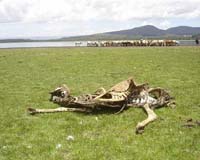 |
Bonn, Germany (SPX) Jan 25, 2010 Following the devastating earthquake on Haiti, relief organisations require rapid, reliable and meaningful information on the local situation, the state of the infrastructure and the extent of the damage for their deployment in the disaster zone. In this context, scientists from the German Aerospace Center are giving important support by providing free access to maps of the crisis region based on satellite data. At the moment, the researchers are focusing particularly on Port-au-Prince, the capital of the Caribbean island state, which has been particularly badly affected. The geographer and DLR scientist Dr Tobias Schneiderhan is coordinating the work of the Center for Satellite Based Crisis Information (Zentrum fur satellitengestutzte Kriseninformation; ZKI) in the case of Haiti. ZKI is a part of DLR, under the umbrella of the German Remote Sensing Data Centre in Oberpfaffenhofen. On behalf of DLR, the centre belongs to the 'International Charter on Space and Major Disasters', an important initiative by space agencies in relation to natural disasters. Under the charter, ZKI makes available satellite data, particularly those from the TerraSAR-X satellite developed and operated by DLR, in crisis situations in Germany and worldwide, analyses satellite data and performs additional functions such as those of the coordinating project manager.
An overview for international relief organisations From here, the information is then passed on to, among others, relief organisations such as the German Federal Agency for Technical Relief (Technisches Hilfwerk; THW) or the German Red Cross. The initial assessment of the situation supports rescue teams in their work, but also provides assistance in the search for suitable locations for the installation of water treatment plants or mobile hospitals. At a European level, the ZKI products are used by the 'Monitoring and Information Centre' (MIC) in Brussels. "With the earthquake in Haiti, we have a very complex situation with extremely extensive damage and very many affected people," Dr Schneiderhan says. In order to give the national and international relief organisations an overview of the nature and quantity of the destroyed infrastructure, about 25 DLR scientists have worked many shifts in recent days to collect, process and analyse radar and optical data. "We must process high resolution raw data has quickly as possible and make it available in the form of generally comprehensible maps so that the relief workers in the disaster area know which roads are still usable, where houses are standing, where there are open areas such as large car parks or stadia which could, for example, be used for emergency relief facilities," DLR scientist Schneiderhan explains.
Before-and-after comparison maps ZKI is a service of DLR's German Remote Sensing Data Center. Its task is the rapid acquisition, processing and analysis of satellite data in the event of natural and environmental disasters, for humanitarian relief activities and for civil defence. The analysis is tailored to meet the specific requirements of national and international institutions as well as relief organisations.
Share This Article With Planet Earth
Related Links German Aerospace Center (DLR) Earth Observation News - Suppiliers, Technology and Application
 Kenyan herders get satellite livestock insurance
Kenyan herders get satellite livestock insuranceNairobi (AFP) Jan 21, 2010 Researchers on Friday launched an insurance scheme for Kenyan herders using satellite images to provide broader and fairer compensation for livestock losses. Launched in northern Kenya's pastoralist -- or livestock raising -- Marsabit region, the Index-Based Livestock Insurance (IBLI) uses vegetation images to estimate cattle mortality as a function of forage loss. Project leader Andrew ... read more |
|
| The content herein, unless otherwise known to be public domain, are Copyright 1995-2009 - SpaceDaily. AFP and UPI Wire Stories are copyright Agence France-Presse and United Press International. ESA Portal Reports are copyright European Space Agency. All NASA sourced material is public domain. Additional copyrights may apply in whole or part to other bona fide parties. Advertising does not imply endorsement,agreement or approval of any opinions, statements or information provided by SpaceDaily on any Web page published or hosted by SpaceDaily. Privacy Statement |